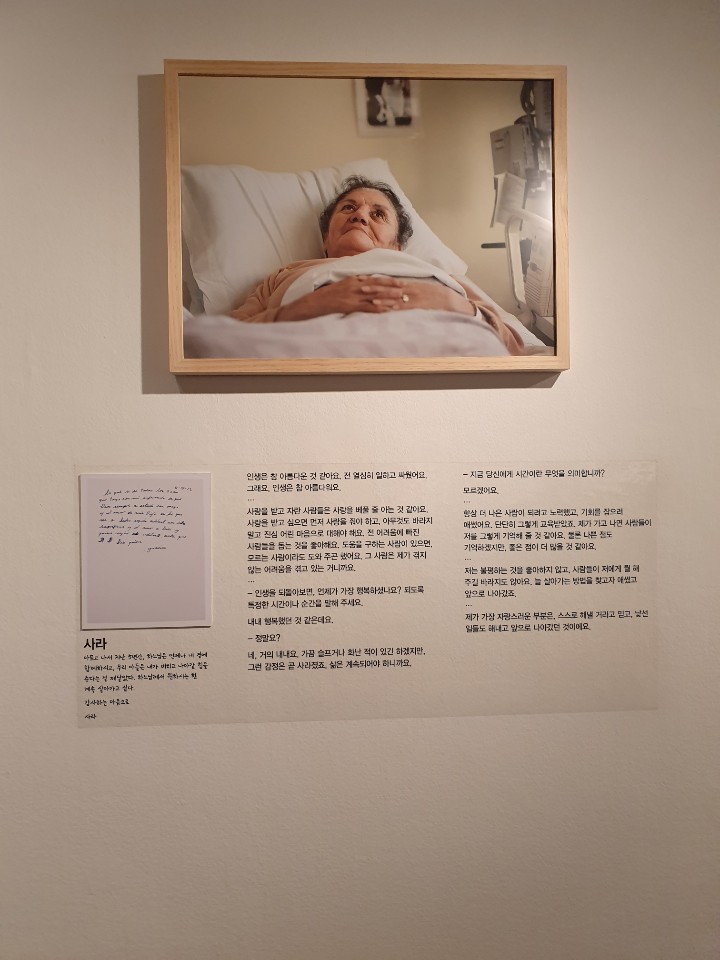May is the month of family here in Korea, with Children’s Day on the fifth and Parents’ Day on the eighth. While we are the only country to celebrate parenthood on this specific date, many countries around the world choose to honor their parents in this month of spring. Children’s Day is a national holiday and families reunite to enjoy the day off together. Our family (and, evidently, many others) decided to enjoy the scenic walk around Majang River, a two-hour drive from our home. But before that, I decided to visit “Right, Before I Die”, a small photography exhibit at Chungmu Arts Center. The exhibition introduces 20 people with a photo and short interview from each person. Young and old, married and unmarried, male and female — each person has a unique story but all of them have one thing in common — they are facing their impending death and do so in peace. Although the interviews were short, they were a lot to take in. Knowing that each response was given in the imminence of death added much more weight to each word. They were asked about their first reaction to the news, their happiest moments in life, their hardest times, and so on. Some reminisced about the romantic relationships in their lives while others shared their religious views. However, all of them responded alike to one particular question: “What is the happiest moment of your life?” The answer was family. To Odis, it was a trip to Alaska with her fourth husband. To Ediccia, it was chatting with her grandmother while having coffee. To Ralph, it was traveling with his father as a child. It was these ordinary moments, once taken for granted, that were the happiest and most memorable in their lives.

However, it was not only those with whom they shared marital or biological kinship that were mentioned. To some, friends had an equally important role in their lives. John said he received much help from those around him after his sickness. In fact, it was his neighbor who took him to the hospital and paid for his bill. On the other hand, Kim shared that many of her friends abandoned her after the unfortunate news. However, those who remained to help her through her hardship were the ones whom she least expected. When asked about the purpose of life, they answered that helping and making others happy give them meaning in life. Donald said that bringing joy to his loved ones is his purpose in life. If Michael could go back to any point in his life, he would return to Mexico and help the underprivileged there once again. It was not only receiving love but also sharing it that gave their life significance.
Looking through the gallery reminded me of my visit to Kkottongnae, a shelter for the homeless and disabled. To help us understand those at the shelter better, we were to experience physical disability by attempting everyday activities after applying blindfolds and tying our legs together. Simple actions such as moving across the room and going up the stairs took ten times the effort, and it reminded us not to take the simple things for granted. In the end, as we were panting and sweating, the instructor asked an unexpected question: “Who here has no regrets in their life?” No one raised their hand. “Those who can answer affirmatively do not need to partake in this exercise,” he continued, “because it means they appreciate the small things in life and do not take anything for granted.”
Family trips had never been exciting. We could not decide where to go or what to eat and we would often end up arguing. I was not particularly excited for our trip to the river either, but my visit to the gallery changed my perspective. The place or food was not what mattered. It is simply the presence of each other that brings us happiness. As I gave my parents a bouquet of carnations for Parents’ Day, I hoped that, one day, I will be able to confidently raise my hand and proclaim that I have no regrets.

